Trees Birds Mammals Fish Amphibians Reptiles
Wild Algarve
Bookshop
Dactylorhiza fuchsii - Common Spotted-orchid
Phylum: Magnoliophyta - Class: Liliopsida - Order: Orchidales - Family: Orchidaceae
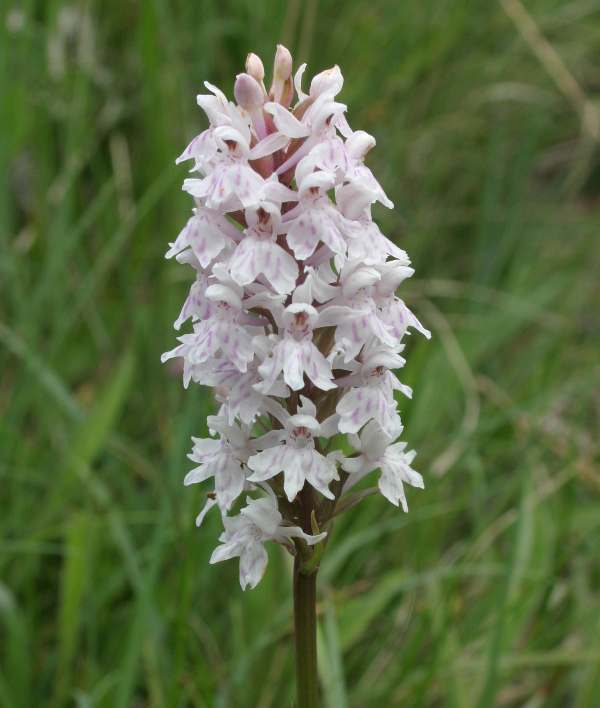
Common this orchid may be, but it is no less beautiful for that. The variations in colour and lip-markings between specimens bear testimony to the visual diversity that can be seen in a single orchid species.
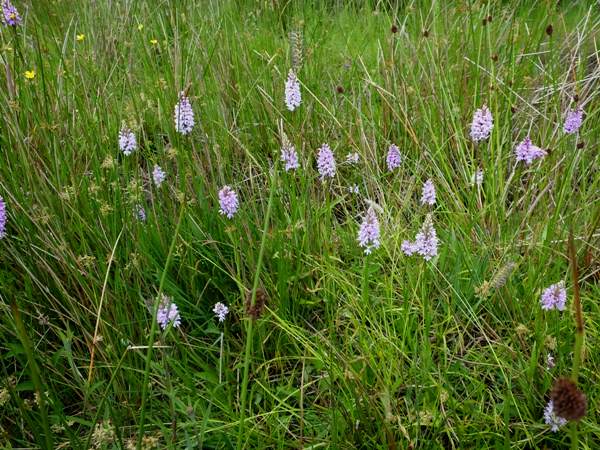
Above: Common Spotted-orchids at Marfield Wetlands Nature Reserve, Yorkshire UK
Description
This orchid usually grows to between 20cm and 50cm tall, but specimens up to 70cm in height can sometimes be found; this makes it generally taller than the Heath Spotted-orchid Dactylorhiza maculata with which it is often confused.
The lip of the Common Spotted-orchid has an exaggerated central tooth.
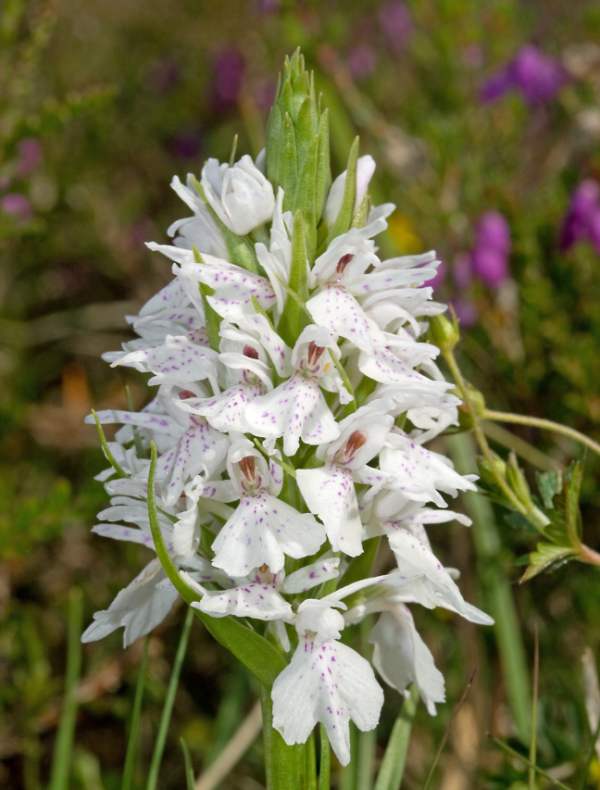
Distribution
Found throughout most of Britain and Ireland, the Common Spotted-orchid can be seen in many countries of mainland Europe including Slovenia, where it grows in its thousands on roadside verges.
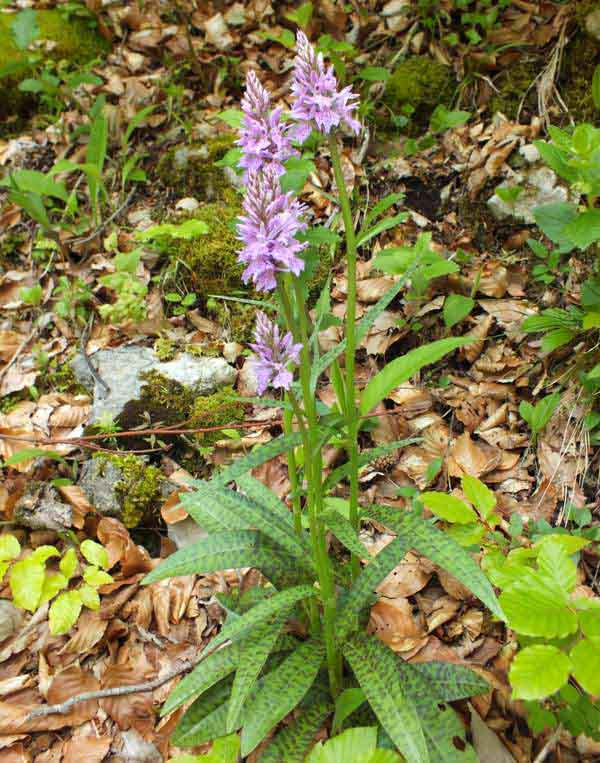
Habitat
This orchid is very common in Wales, where we live, and pops up all over the place - in the sand dunes at many of our coastal nature reserves, on roadside verges, roundabouts and central reservations (they thrive there because of the limestone chippings used to assist with drainage) as well as in unimproved grassland sites.
Provided the soil conditions are calcareous and the ground has not been doused with pesticides and herbicides you are quite likely to find the Common Spotted-orchid.
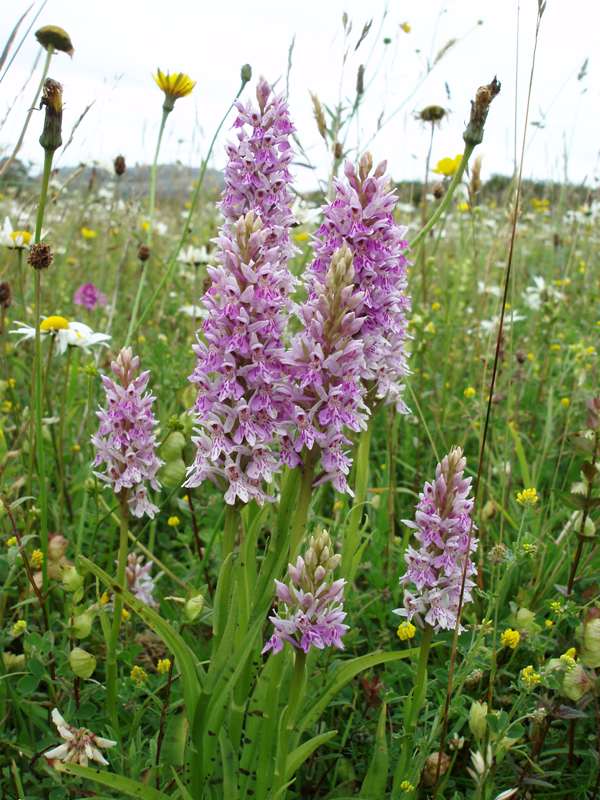
Flowering times
In Britain and Ireland the peak flowering time for Common Spotted-orchid is June.
Also found in Wales are the hybrid with Southern Marsh-orchid Dactylorhiza praetermissa, - Dactylorhiza fuchsii x grandis - and the variety Dactylorhiza fuchsii var. rhodochila. The latter is rare, while the former is probably very common but may be easily confused with either or both parent plants.
Dactylorhiza fuchsii x grandis is a tall and robust plant with darkly-spotted leaves and deep-pink flowers. It is found where both parents occur, and occasionally where they apparently do not. This hybrid plant is capable of producing seed, and so hybrid swarms sometimes occur.
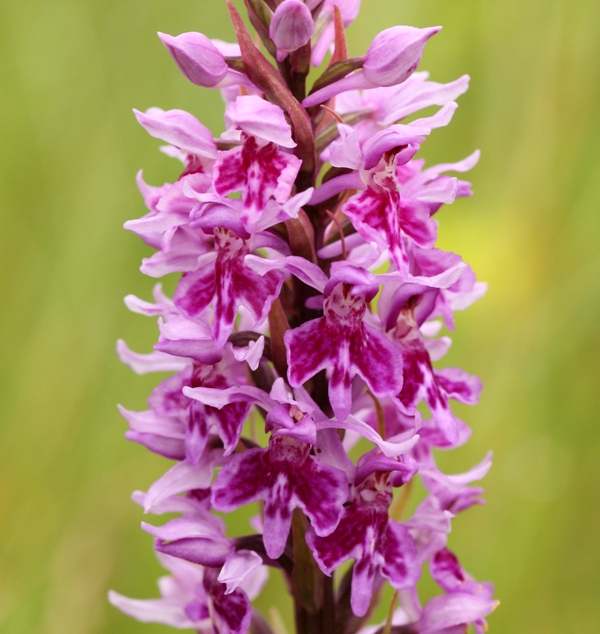
Above: Dactylorhiza fuchsii var. rhodochila - Picture courtesy of Elaine Hagget...
Dactylorhiza fuchsii var. rhodochila is widespread throughout the UK but rare. The leaves of the plant are more heavily spotted and are also sometimes reported as being almost completely purple. The lip of the flower is also a distinguishing feature, having a block of dark purple colouring, due to excessive pigmentation, in the centre and with a paler border. The specimen shown on this page was photographed in Wales in June.
Hybrids and Varieties
Hybrids:
- Dactylorhiza x transiens is the hybrid with Heath Spotted-orchid Dactylorhiza maculata.
- Dactylorhiza x kernerorum is the hybrid with Early Marsh-orchid Dactylorhiza incarnata.
- Dactylorhiza x mixtum is a rare hybrid with the Frog Orchid Dactylorhiza viridis.
- Dactylorhiza x venusta is the hybrid with Northern Marsh-orchid Dactylorhiza purpurella.
- Dactylorhiza x grandis is the hybrid with Southern Marsh-orchid and is widespread in southern Britain (see above).
- Dactylorhiza x silvae-gabretae is the hybrid with Narrow-leaved Marsh-orchid
- Dactylorhiza traunsteinerioides.
- Dactylorhiza x braunii is the hybrid with Irish Marsh-orchid Dactylorhiza occidentalis and is recorded from County Clare.
Intergeneric hybrids
- X Dactylodenia st-quintinii is the hybrid with Fragrant Orchid Gymnadenia conopsea and and there are possibly further intergeneric hybrids with Britain's other two Fragrant Orchids, Heath Fragrant-orchid Gymnadenia borealis and Marsh Fragrant-orchid Gymnadenia densiflora.
Varieties:
- Dactylorhiza fuchsii var. albiflora has unmarked white flowers and is fairly widespread.
- Dactylorhiza fuchsii var. alpina has small, darker flowers and is found in Scotland and parts of northern England; it has also been reported from Wales.
- Dactylorhiza fuchsii var. cornubiensis is a smaller plant with a relatively large infloresence and larger flowers; it is found in Cornwall.
- Dactylorhiza fuchsii var. albiflora has unmarked white flowers and unspotted leaves; it is widespread but uncommon.
- Dactylorhiza fuchsii var. okellyii is somewhat contentious: it resembles
- Dactylorhiza fuchsii var. albiflora but the leaves can be either spotted or unspotted; this variety is thought to be confined to western Ireland, the Isle of Man and parts of Scotland.
- Dactylorhiza fuchsii var. rhodochila is a widespread but rare hyperchromatic variant with excessive pigmentation; the lips of its flowers are reddish purple with a paler border, and the leaves can have either heavily marked or completely purple leaves.
Etymology
The genus name Dactylorhiza means 'finger-like roots', while the specific epithet fuchsii honours the German botanist Leonhart Fuchs (1501 - 1566).
Reference sources
The Plant List
Sue Parker (2023) Wild Orchids of Wales - how, when and where to find them; First Nature e-book (Amazon Kindle format)
Sue Parker (2023) Wild Orchids of the Algarve - where, when and how to find them; First Nature e-book (Amazon Kindle format)
Anne and Simon Harrap (2005) Orchids of Britain and Ireland; A&C Black
Pierre Delforge (2005) Orchids of Europe, North Africa and the Middle East; A&C Black
Sue Parker's latest ebook is a revised and enlarged edition of Wild Orchids in The Burren. Full details here...
Buy it for just £5.95 on Amazon...
Sue Parker's new ebook is a comprehensive and fully revised edition of her acclaimed field guide to the Wild Orchids of Wales. Full details here...
Buy it for just £5.95 on Amazon...
Sue Parker's 5-star acclaimed field guide to the Wild Orchids of the Algarve is now available as an ebook. Full details here...
Buy it for just £5.95 on Amazon...
Please Help Us: If you have found this information interesting and useful, please consider helping to keep First Nature online by making a small donation towards the web hosting and internet costs.
Any donations over and above the essential running costs will help support the conservation work of Plantlife, the Rivers Trust and charitable botanic gardens - as do author royalties and publisher proceeds from books by Pat and Sue.